——— W ———
W – the abbreviation for watt.
wah pedal – see wah-wah pedal.
wah-wah pedal – a type of guitar effects pedal that alters the tone of the signal to mimic the human voice. The sound is created by sweeping a filter up and down in frequency. Also called a wah pedal.
walking bass – a style of playing bass in which a note is played on each beat of the bar and which typically moves up or down the scale in small steps.
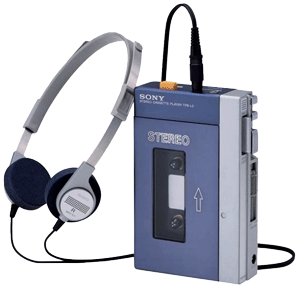
Walkman™ – a trademark of Sony originally used for portable audio cassette players, but now used to market a line of portable audio and video players. The original Walkman introduced in 1978 brought about a change in music listening habits by allowing people to take their music with them and listen on lightweight headphones.
walla – a sound effects that emulates the murmur of a crowd in the background. It is called walla because during the early days of radio, it was discovered that several people repeating the word “walla” in the background sounded like the indistinct chatter of a crowd. Today, walla actors use real words and conversations, usually improvised.
wall-mounted monitors – see soffit-mounted monitors.
wall of sound – (1) A technique used in pop and rock music developed by producer Phil Spector in the 1960s, consisting of a dense, layered, and reverberant sound created by having instruments perform the same parts in unison and using arrangements that included large vocal groups and orchestras, often enhanced with both tape delay and an echo chamber. (2) A stereo microphone technique developed in the 1930s by Harvey Fletcher at Bell Laboratories that consisted of a large array of microphones (as many as 80) hung in a line across the front of an orchestra with each being played back into a corresponding loudspeaker in the same arrangement, creating a precise imaging and realistic perspective. However, recording and reproducing a large number of discrete signals was not practical. When the microphone array was simplified, the minimum number of microphones to produce acceptable results (the best compromise between high-quality imaging and practicality) turned out to be three microphones with three loudspeakers. The three-spaced-microphone technique (such as the Decca Tree) is still in widespread use.
wall wart – slang for a power adapter.
WAM – Women's Audio Mission.
WAN – Wide Area Network.
wand – the beater used to play a triangle.
warm – (1) A descriptive term for a sound with good bass response and good fundamentals relative to the harmonics. (2) A descriptive term for a sound with excessive bass and midbass. (3) Pleasantly spacious with good reverberation in the lower frequencies. Opposite of cold.
warm highs – sweet highs. See sweet.
Warner Music Group (WMG) – a record company founded in 1958 as Warner Brothers Records and headquartered in New York, NY. It began as a spinoff from the movie company to avoid having its actors recording for rival companies. In 1963, Warner purchased Reprise Records, which had been founded by Frank Sinatra in 1960. In 1967, Warner Bros. was purchased by Seven Arts Productions, becoming Warner Bros.-Seven Arts). It then purchased Atlantic Records and its subsidiary Atco Records. In 1969, Warner Bros.-Seven Arts was sold to the Kinney National Company. In 1969, a joint distribution network was established for Warner, Elektra, and Atlantic Records. In 1970, Kinney bought Elektra Records and Nonesuch Records, and in 1972 the company was renamed Warner-Elektra-Atlantic (WEA). In 1972, Kinney National spun off its non-entertainment assets as National Kinney Corporation and changed its name to Warner Communications, Inc. The same year, Warner acquired David Geffen's Asylum Records. In 1990, Warner Communications merged with Time, Inc. forming Time Warner. WEA was renamed Warner Music in 1991, and in 2000 with the addition of AOL, became Warner Music Group. In July 2013, WMG acquired the Parlophone Label Group.
WASAPI – Windows Audio Session Application Programming Interface. A driver that enables DAWs and other audio applications to manage the flow of audio data between the application and a device for Windows 7 and above.
waterfall curve or waterfall plot – see energy-time curve.
watt (W) – an SI unit for measuring electrical power. It is defined as one joule per second, and is used to express the rate wat which energy is converted or transferred. One watt is also the rate at which work is done when one ampere of current flows through an electrical potential difference of one volt. It is named for the Scottish engineer James Watt.
watt-hour (Wh) – a unit of energy equivalent to one watt (W) of power expended for a period of one hour. The watt-hour is commonly used in electrical applications. The energy of 1 Wh is equivalent to 3,600 joules (J).
WAV – see Waveform Audio File Format.
.wav – file extension for the Waveform Audio File Format.
wave – the up and down fluctuation of anything over time. There are four parameters that specify a wave: wavelength, period, frequency, and amplitude.
WAVE – see Waveform Audio File Format.

wave crest – the point on a wave where it exhibits the maximum amount of positive or upward displacement from the rest position. The opposite of wave trough. Also called a crest or peak.
wave cycle – one complete motion of a wave as it goes from any starting point to the maximum point of positive or upward displacement (crest) and then through the minimum point, maximum amount of negative or downward displacement, (trough) and then back to the starting point. This also defines its wavelength.
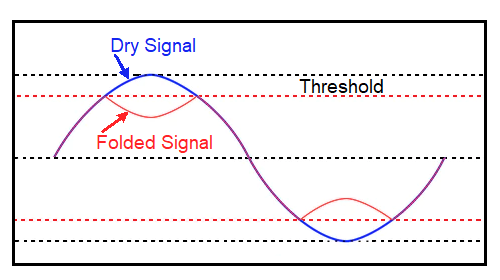
wave energy – the amount of power at a certain point in a wave. The energy of a sound wave is proportional to its amplitude and is perceived as loudness by the human ear.
wave file – see Waveform Audio File Format.
wave flank – see bank.
wave fold – a type of distortion synthesis that when the input amplitude exceeds the threshold, the curved amplitude peak gets inverted or reflected back into one or more folds.

waveform – the shape of a wave as represented on a graph of amplitude vs. time, a visual representation of an audio file. A waveform can be as simple such as a sine wave, square wave, sawtooth wave, and triangular wave or a complex wave. Also called wave shape.
Waveform Audio File Format (WAVE) or (WAV) – the standard Microsoft and IBM audio file format having the extension .wav, usually used for storing uncompressed audio bitstreams on Windows computers. It uses the RIFF format as a wrapper that can contain a variety of audio coding formats including compressed audio, but the most common WAV format is uncompressed audio in the LPCM (linear pulse code modulation) format, which is the standard audio coding format for audio CDs. WAV files use the .wav extension or, less commonly, .wave extension. They are often called WAV files or wave files and occasionally they are called Audio for Windows. See also BWF and AIFF.
wavefront – the leading edge of a wave as it propagates through a medium. For example, when you throw a pebble into water, the first circle of waves that spreads from the point of impact is the wavefront.
waveguide – a structure or mechanism that directs waves in a certain direction or pattern. In audio, waveguides are baffles used in speakers and studio monitors to direct sound waves in order to optimize dispersion, phase coherence, and/or frequency response.
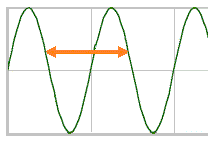
wavelength (λ) – the length of one cycle of a wave. Wavelength is related to frequency according to the formula v = f × λ, where v is the velocity of sound, f is the frequency, and λ is the wavelength. See also amplitude.
wavelength-division multiplexing (WDM) – a technology that allows a number of data streams to be carried at the same time on a single optical fiber, with each signal using its own separate color (wavelength), including bidirectional communications. WDM systems can be divided into three different versions: (a) normal (WDM), (b) coarse (CWDM), and (c) dense (DWDM). Normal WDM, sometimes called band wavelength-division multiplexing (BWDM), has two channels. Coarse wavelength division multiplexing (CWDM) can have up to 16 channels. Dense wavelength division multiplexing (DWDM) can have 40 channels with 100-GHz spacing or 80 channels with 50-GHz spacing.
wave shape – see waveform.
wave speed – see wave velocity.
wavetable – a collection of digital representations of sounds, which can be stored and then accessed by a computer or synthesizer to reproduce a sound. See also sound synthesis and wavetable synthesis.
wavetable synthesis – a method of sound synthesis (creating a sound with a synthesizer) in which digitized waveforms organized in banks (the wavetable) can be randomly accessed. See also AM Synthesis, additive synthesis, subtractive synthesis, sample synthesis, and FM synthesis.

wave trough – the point on a wave where it exhibits the maximum amount of negative or downward displacement from the rest position. The opposite of wave crest. Also called a trough.
wave velocity – the distance traveled by a wave in a given amount of time. Sometimes called wave speed, although technically velocity implies both speed and direction.
WavPack – a free, open source lossless audio file format, that can compress files by 30 to 70%, depending on the source. WavPack compression can compress and restore WAV files. It uses the .wv file extension.
.wav poly – see poly WAV file.

wax a disc – slang for making a recording.
wax cylinder – the earliest mass market medium for recording and reproducing sound that consisted of a cylinder made of wax (originally a mixture of paraffin and beeswax) with an audio recording engraved in grooves on the outside surface. Because they became worn after being played a few dozen times, the cylinder was later made using carnauba wax. Introduced later the phonograph disc became a competing medium that eventually won the format war. Both types of media were called “records” at the time. Also called a phonograph cylinder or simply cylinder.
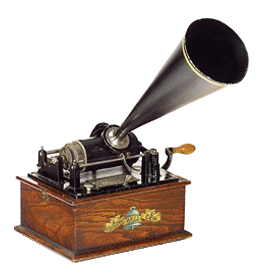
Phonograph
WCSA – see Wide Cardioid Surround Array.
WDM – Windows Driver Model. The protocol for drivers on Windows computers beginning with Windows 98. Previously known as the Win32 Driver Model.
WEA – Warner-Elektra-Atlantic. See Warner Music Group.
web – short for World Wide Web.
web address – see URL.
web audio API – an API for processing and synthesizing audio in web applications. An API is an application programming interface, a set of routines, protocols, and tools that can be used for creating software applications, expressed in terms of its operations, inputs, and outputs. A web audio API uses an audio routing method on a graph, with a number of interconnecting nodes that define the overall audio rendering, which is processed within the browser or by JavaScript.
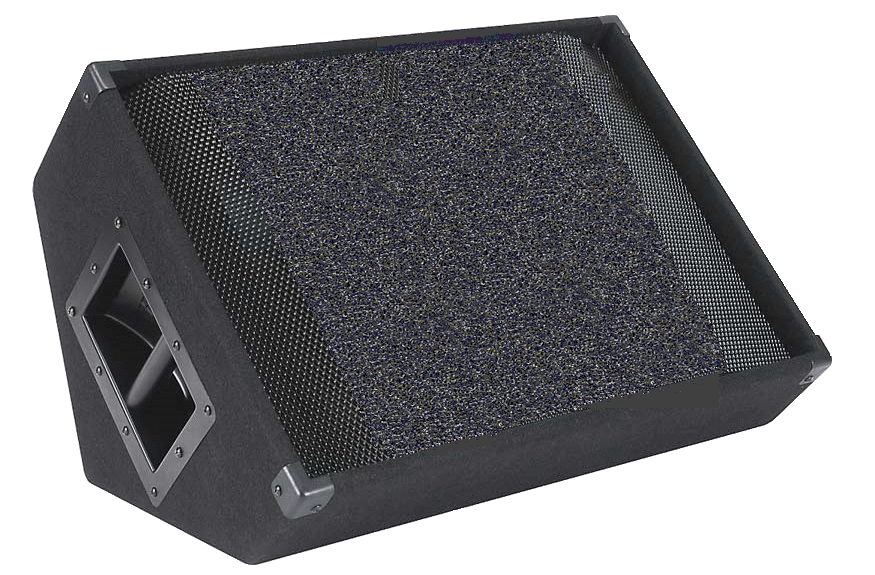
webcasting – see internet radio.
weber – a unit to measure magnetic flux.
web radio – see internet radio.
wedge – a specially-shaped speaker used on stage as a monitor. The wedge shape directs the sound upwards from the floor to the perfomers' ears.
wedge technique – a stereo microphone technique that uses two boundary microphones—pressure zone microphones (PZMs)—mounted on a V-shaped wedge, about 6 inches (15 cm) from the tip of the V, with the point of the wedge aimed at the music source. The wedge consists of two square panels approximately 2 feet (60 cm) on each side and joined together on one side to form a V with an angle of 70 degrees. It is in the baffled-microphone category. Other techniques in this category include baffled-omni pair, Jecklin disc technique, Schneider disc technique, and sphere microphone.
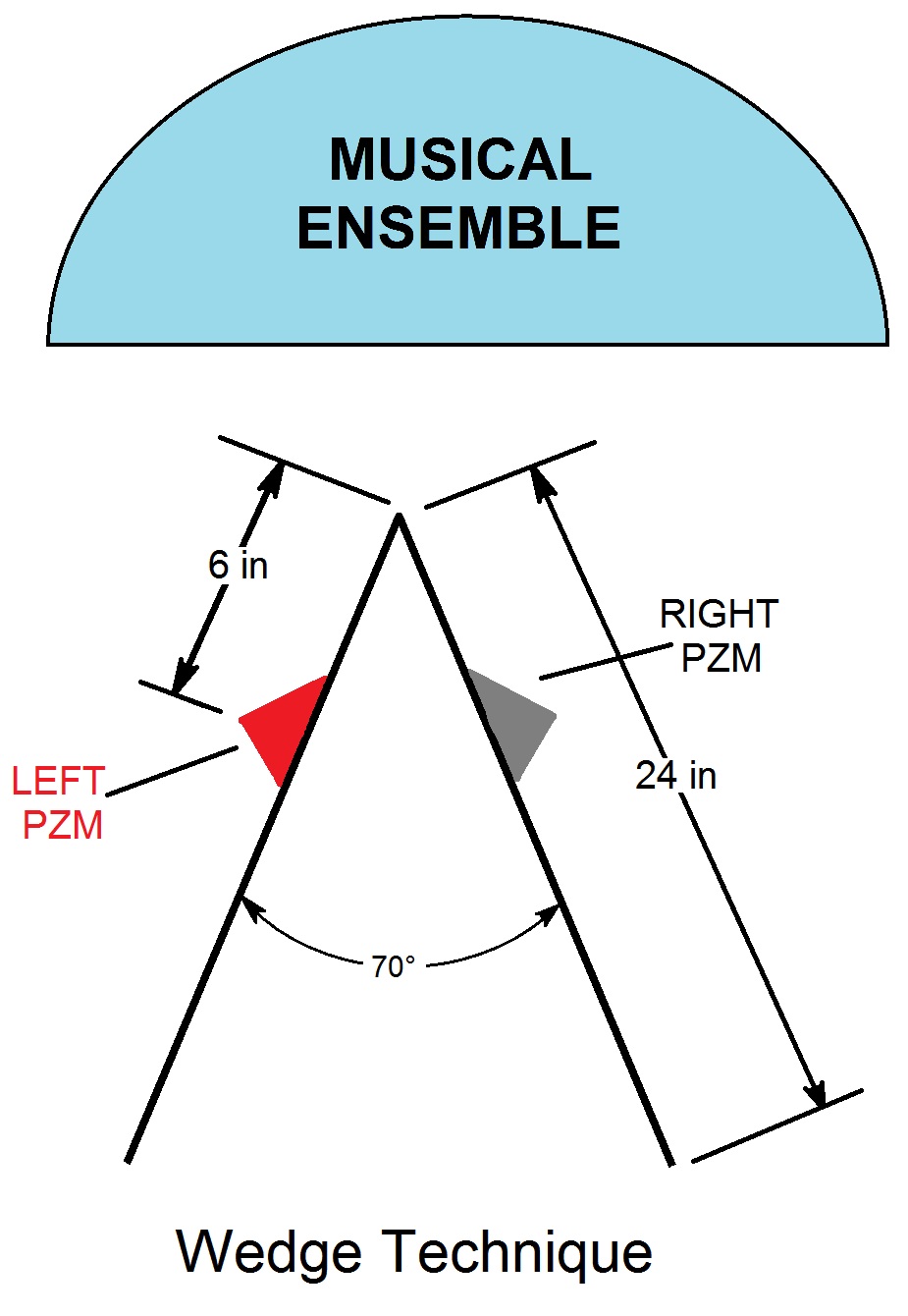
weighting – (1) Measurement of sound using an equalization curve with a response that simulates that of human hearing, such as A-weighting, B-weighting, C-weighting, and K-weighting. Sometimes called frequency weighting. See also the Fletcher-Munson effect. (2) A means of adjusting audio levels of channels in a multichannel signal.
weighting network – a filtering network or active equalizer calibrated for use in weighting.
weighty – a descriptive term for a sound with a heavy bottom end. Compare with heavy.
well – one of a number of openings (usually square) of various depths that are found in quadratic-residue diffusers primitive-root diffusers,and other diffuser designs.
Western Electric Company (WE) – from 1881 to 1995 a US electrical engineering and manufacturing company that supplied products to AT&T, and was part owner of Bell Laboratories. It is credited with developing an number of technological innovations. It also was the procurement agent for the member companies of the Bell System.
western music – (1) A term generally applied to music in the European tradition, as opposed to music from eastern cultures, such as Chinese and Indian music, which are based on scales different from music in western cultures. (2) A form of American folk music concerned with the people who settled and lived in the American West and Western Canada during the latter half of the nineteenth century.
wet – (1) Consisting entirely of processed sound. The opposite of dry. (2) Having reverberation and ambience.
wet/dry mix – a control found on many signal processors that adjusts the proportion of the mix between the original (dry) and the affected (wet) signals. When the effect is on an auxiliary track, the wet/dry mix is usually set at 100% wet with amount of the effect being controlled by the level of the auxiliary track.
whammy bar – see tremolo bar.
wheel – short for jog wheel.
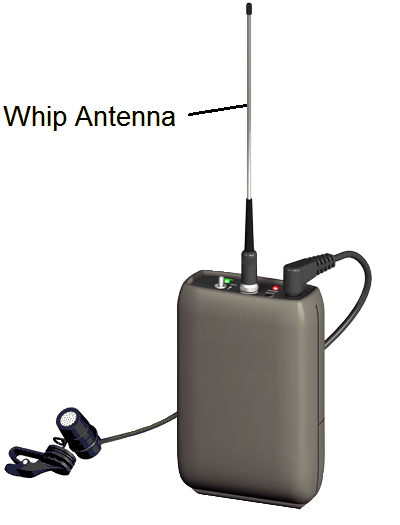
for Wireless Mic
whip antenna – an antenna consisting of a usually flexible wire or rod, typically about a quarter wavelength in length, mounted on a receiver or transmitter and used as a counterpoise.
whistle – a small device or instrument that makes a loud and high-pitched sound when air is blown through it. See also penny whistle.
whistle register – the highest register of the human voice, being higher than the falsetto register. The timbre of the notes produced from this register are similar to that of a whistle. Also called the flageolet register, flute register, or whistle tone.
whistle tone – see whistle register.
White Book – specifications for CD Video developed by JVC, Panasonic, Philips, and Sony. Video CD did not become a commercial success. See also Blue Book, Red Book, Yellow Book, Green Book, and Orange Book.
white label – a vinyl record released with a plain white label as an advance promotional copy to radio stations and deejays before release to the general public.
white light – electromagnetic radiation with all the frequencies of visible light at equal intensity, which appears white to the human eye.
white noise – a random noise in which the energy content is the same at each frequency, analogous to white light. See noise colors.
white space – (1) Unoccupied space between active TV channels implemented to avoid interference between adjacent channels. (2) A frequency allocated for a particular broadcasting service that is not used locally. (3) Unused radio spectrum that either has never been used or has become available due to changes in frequency allocations. Also spelled whitespace.

white space device – see TV-band device.
whole bend – see bend.
whole note – a music note having the time value of two half notes or four quarter notes. In 4/4 time, a whole note has the time value of 4 beats. It is the longest note in common use.
whole rest – a rest that has the same length as a whole note.
whole step – see whole tone.
whole tone – in music, two semitones, two half-step increments of pitch in tonal music; two notes spaced ⅙ of an octave apart. Also called a whole step.
wide area network (WAN) – a network of computers connected far apart, typically greater than a half a mile. WANs may be used to interconnects multiple local area networks (LANs) over a large geographical area, such as connecting a company headquarters with branch offices and other facilities. A WAN allows users to share access to applications, services, and other resources.
wideband – (1) A relatively wide range of frequencies. Also called a broadband. See also narrowband. (2) An FM radio signal in which the deviation is much greater than the modulating frequency.
wideband de-esser – see split-band de-esser.
wide cardioid – see subcardioid.
wide cardioid surround array (WCSA) – a surround sound microphone technique developed by Mikkel Nymand. It is a variation of the Corey/Martin tree that uses matched cardioid microphones. It consists of three cardioid microphones facing the front, and two cardioid microphones facing up. The distance between the left and right front mics is 120 cm (48 in) with the center mic halfway between them. The rear surround cardioids are 30 cm (12 in) apart and about 60 cm (24 in) behind the front pair. The center microphone can be moved forward up to 15 cm (6 in), if needed. These distances can be adjusted depending on the size of the ensemble being recorded. A front spacing of 120 cm (48 in) is used for smaller ensembles, increasing to 180 cm (6 ft) for larger groups. This array is supposed to create an intense, dynamic, and enveloping sound character.
widescreen – any television or movie picture format with an aspect ratio greater than 1.33:1.
Wi-Fi – a system for wireless local area networks (LANs) using the 2.4-gigahertz (ISM) band. Wi-Fi uses the 802.11 protocol, which has several specifications as established by the IEEE, with each having a set of various transmission methods and data rates. These include 802.11b (the original Wi-Fi spec), 802.11g, and 802.11n.
wild lines – see wild track.
wild sounds – see wild track.
wild time code – a slang expression for a time code that runs at its own pace without regard to a known reference standard. This becomes a problem when you try to sync it to another audio or video project that uses a standard time code.
wild track – an audio recording usually having sound effects, random dialog, background noises, etc. intended to be synchronized with a film or video but recorded separately. Also called wild sound or wild lines.
winding – see coil.
wind instrument – a musical instrument in which sound is produced by the vibration of a column of air. Woodwinds and brass instruments are both wind instruments, but keyboard instruments such as an organ or accordion are not. See also instrument families.

Windjammer® – a trade name belonging to Rycote for a windscreen cover for microphones made of long synthetic fibers similar to a fluffy.
window – the frequency band in which a device operates, such as the passband of a bandpass filter.
windowboxing – displaying video with both letterboxing and pillarboxing simultaneously, black bars on all four sides of the image. Also called the postage stamp effect, gutterboxing, or matchboxing.
Windows – a family of operating systems (OS) using graphical user interfaces developed by Microsoft. Windows includes a number of different operating systems, each designed for a particular purpose, such as for personal computers, servers, and smart phones.
Windows Media Audio (WMA) – a proprietary audio file and compression format (codec) developed by Microsoft to compete with the MP3 format. WMA now consists of four different codecs: (1) the original WMA codec (WMA), (2) WMA Pro, a more advanced codec that supports multichannel and high resolution audio, (3) WMA Lossless, a lossless codec that compresses audio data without loss of audio fidelity, (4) WMA Voice, a low-bit-rate compression scheme designed for voice content.
windshield – see windscreen.

windscreen – a device made of foam or cloth that fits over a microphone used to reduce the amount of wind noise. Sometimes called a windshield. Sometimes spelled wind screen. See also pop filter.
wipe – a function in some DAWs that deletes the clips in a track, but leaves the properties.
wiper – the movable contact in a potentiometer. Also called the arm.
wire – (1) A thin drawn-out metal used to carry electric currents or signals, which may be insulated or uninsulated. It can be either stranded or solid core. (2) The conductors inside a cable. (3) To install wires and components into an electric circuit.
wire harness – see wiring harness.
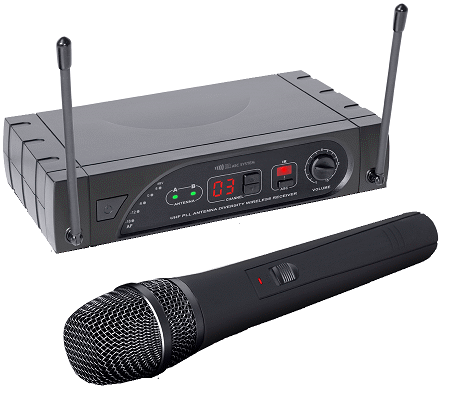
and Receiver
wireless – (1) A tool, appliance, or other device that uses batteries and thus eliminates a power chord (wire). (2) A method of transmitting signals using radio waves as opposed to using cable. (3) Short for wireless microphone. (4) An old British term for a radio.
wireless cable – see multichannel multipoint distribution service.
wireless microphone – a microphone that contains a miniature transmitter that sends radio signals to a nearby receiver, thus eliminating cables and wires. Sometimes called a radio microphone, RF microphone, or cordless microphone.
Wireless Multi-Channel Audio Systems (WMAS) – a new wireless audio technology introduced by Sennheiser in 2023. WMAS is a bi-directional, broadband wireless technology that can combine wireless microphones, instruments, in-ear monitors (IEM), and remote controls into one broadband RF channel. A traditional narrow-band wireless system is limited to a bandwidth of 200 kHz with a maximum power output of 50 mW without a license. As the number of narrow-band systems operating in a local area increases, the power spectral density (PSD) increases, which can cause distortion or interference with nearby systems. PSD is the total signal power in a specified spectral bandwidth divided by the bandwidth (watts/hertz). The transmit power of a WMAS system is also 50 mW, but the entire system operates at 50 mW, regardless of the number of audio channels being used. WMAS requires a wide band for transmission, 6 MHz in North America or 8 MHz in European countries (the bandwidth of one TV channel in each respective region). Unlike narrow-band wireless, the 50-mW transmission of a WMAS system is not confined to a 200-kHz band, but is spread across the entire 6-MHz (8-MHz in Europe) band. This results in a power spectral density that is 30 to 40 times lower than that of a conventional wireless microphone. This reduces the chance of interference from nearby neighbors using the same frequency, such as theaters on Broadway. Being bidirectional means it can operate as both a transmitter and receiver at the same time, allowing, for example, transmitting an instrument signal while simultaneously receiving an IEM mix, therby reducing the number of packs worn by a performer
wire loom – see wiring harness.
wire recorder – an audio recording device that preceded the tape recorder. Instead of plastic tape coated with iron oxide, the wire recorder used a steel wire. It was invented in 1898, but didn't see much commercial development until the 1910s when it was used primarily as a dictation machine. Early models suffered from poor quality audio. Most of these problems were worked out by the 1950s, but by that time, the tape recorder had taken over the market.
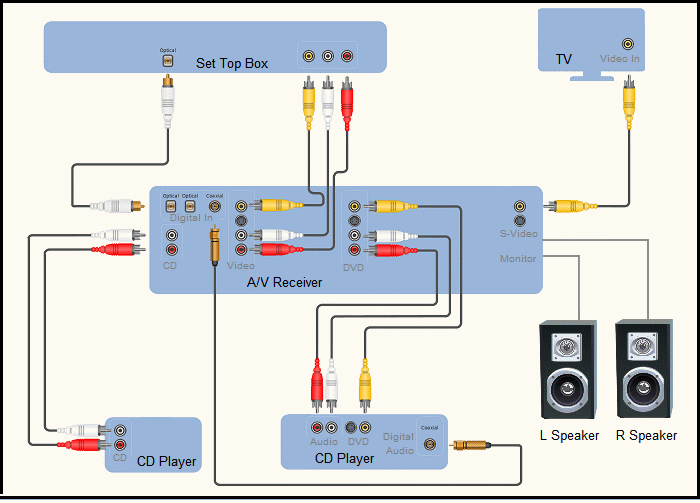
wiring – (1) A system of wires providing electric circuits for a device or that carry electricity in a particular place or building. (2) Installing wires in a circuit or building.
wiring assembly – see wiring harness.
wiring diagram – a simplified pictorial representation of an electrical circuit or system that shows the components as symbolic shapes and the signal and power connections as lines between them. Wiring diagrams usually show the relative position and arrangement of components and terminals unlike schematic diagrams where the arrangement of connections and components are not the actual physical locations. Wiring diagrams are used for constructing and servicing components and setting up systems.
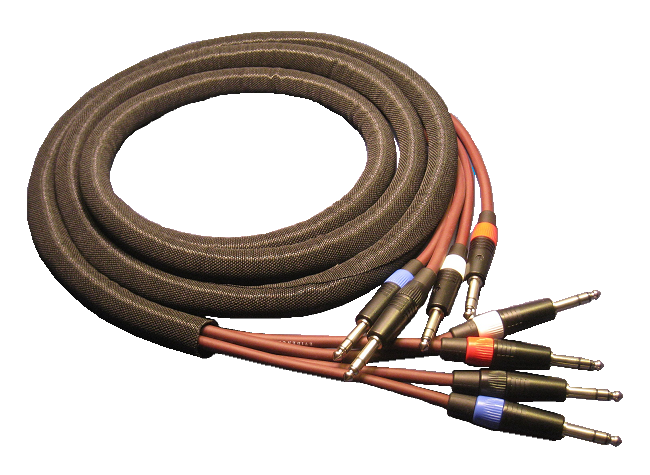
wiring harness – several individual cables bound together for neatness or convenience. The cables are bound together using braiding, straps, cable ties, cable lacing, sleeves, electrical tape, or conduit, or a combination of these. Also known as a harness, wire harness, wiring loom, wire loom, loom, cable harness, cable assembly, or wiring assembly.
wiring loom – see wiring harness.
.wma – file extension for the Windows Media Audio format.
WMAS – Wireless Multi-Channel Audio Systems.
wobble – (1) An undesirable slow wavering of a voice, due to poor voice conditioning, fatigue, or age. (2) A slight, sinusoidal variation from a true spiral in the pregroove of a writable optical disc. See absolute time in pregroove (ATIP).
wobble frequency – see absolute time in pregroove (ATIP).
Women's Audio Mission (WAM) – a non-profit organization founded in 2003 by Terri Winston and based in San Francisco, CA, to promote the advancement of women in recording and music production. WAM also provides hands-on training, work experience, online classes, career counseling, and job placement for women and girls in creative technology for music, radio, film, television, and the internet.
woodwinds – (1) An instrument family of wind instruments in which sound is produced by the vibration of reeds in a mouthpiece, such as clarinet, saxophone, bassoon, oboe, or English horn, or by blowing air across a mouthpiece, such as a flute. (2) The section of a band or orchestra consisting of woodwind instruments. (3) A group of woodwind instruments or their players.
woofer – the driver in a loudspeaker cabinet designed to produce low frequency audio, typically from about 40 Hz up to 1,000 Hz or so. Also called a low-frequency driver.
wooly – a descriptive term for a sound with weak high frequencies, sounding like a wool blanket pulled over the speakers. Similar to blanketed. Also called soggy.
word – a unit of data (a group of bits) that can be handled as a unit by a computer processor or instruction set of a particular design. Word size depends on many aspects of the structure and operation of a computer, such as the size of registers and the amount of data that can be transferred to and from memory in a single operation.
word clock – a signal timing device used by digital audio devices to keep signals synchronized. It is called word clock because it clocks samples which are represented in data words. Sometimes spelled wordclock. See bit clock.
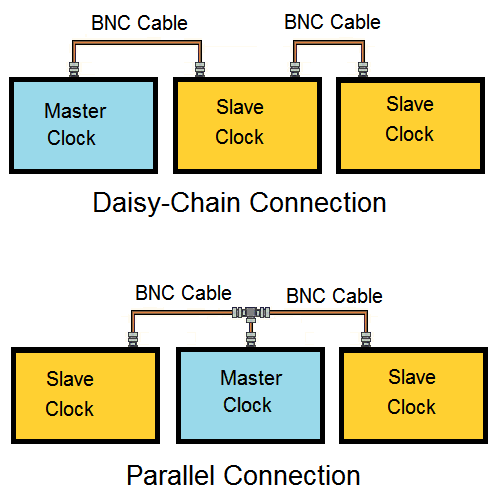
word clock chain – the clocks of two or more digital audio devices being connected together, using one as a masterclock and the others as slaves. The timing signal normally is sent using cables with BNC connectors. The devices can be daisy-chained, in which case each device takes the output timing signal from the previous device as the input to the next device. Alternatively, they can be connected so that the same timing signal goes to all the devices using BNC T connectors.
word-clock jitter – see digital jitter.
word length – see word size.
word size – the number of binary digits (bits) in a word. Typical word sizes in modern processors are 8, 16, 24, 32, or 64 bits. Also called wordsize, word width, wordwidth, word length, or wordlength.
word width – see word size.
work for hire – work created by an employee as part of his or her job, or work created on behalf of a client with the written agreement of all parties that the work is designated as work for hire. Work for hire is an exception to the general rule that the person who actually creates a work is the legal author and copyright holder or patent holder of that work. With work for hire the employer—not the employee—is the legal author according to US copyright and patent law. Also called work made for hire or abbreviated as WFH.
workstation – (1) A group of MIDI and/or computer-related equipment that work together to compose, produce, and record music, such as a keyboard workstation or a digital audio workstation. (2) Short for digital audio workstation.
World Wide Web (WWW) – a space on the internet, created by British scientist Tim Berners-Lee invented in 1989, where documents and other resources are located and identified using Uniform Resource Locators (URLs) and that are linked using hypertext links. The World Wide Web is the primary tool used by people around the world to interact on the internet. Often called simply the web.
wow – a type of distortion caused by speed variations in audio equipment, such as turntables and tape recorders, resulting in a relatively slow variation in the frequency of the reproduced sound. Fast variations are called flutter.
wow and flutter – a measurement of the speed variations in audio equipment, such as turntables and tape recorders, that combines wow and flutter.
wrap – the shape formed by magnetic recording tape as it moves across the tape head.
wrapped plug-in – a plug-in designed for one platform that uses an external program (the wrapper) to enable it to run on another.
wrapper – a software program that acts as a translator to allow a plug-in designed for one type of application to run in another. For example, a wrapper could be used to run a VST format plug-in under RTAS. (2) A container format that usually contains encoded audio and metadata, which includes such information as to the codec, bit rates, and other information needed to decompress the data, as well as title, artist, and other information. Wrappers are usually indicated by their extension, but some wrapper formats can use more than one codec.
write mode – a method of operating DAW automation so that the computer stores the movements of a fader as the track is being played.
wrote a 2 – slang for exceeding 0 dbFS (digital full scale) and creating digital distortion.
W-taper – see taper.
.wv – file extension for the WavPack format.
WWW – World Wide Web.
wye connector – see Y-connector.
Note: We believe this is the largest dictionary (glossary) of terms specific to usage within the recording industry that is currently available on the internet, with more than 8,800 entries, nearly 800 illustrations, and dozens of tables. Some of the terms have different or additional meanings in other situations, especially within the electronic, automotive, scientific, and computer industries. Of necessity there are obvious overlaps into other fields such as music, electronics, and computers, but such excursions are limited to information deemed pertinent to the knowledge required to operate and/or participate effectively in the workings of a recording studio. Also included are terms related to sound reinforcement (live performances) including wireless microphone technology because a working knowledge of that terminology is necessary for recording at live performance venues. Because recording studios also record audio for video and motion pictures (films), some terminology from those fields is included. Some scientific terms are included because they help explain studio terminology. For example, electromagnetism explains how microphones, loudspeakers, and guitar pickups work. Knowledge of radio waves and the radio frequency spectrum is needed to explain wireless devices. Any trademarks or trade names mentioned belong to their respective owners. The information contained in this dictionary is believed to be accurate at the time of publication. This information is subject to change without notice. The information was obtained from and cross-checked with a variety of sources that are believed to be reliable. However, Los Senderos Studio, LLC does not guarantee the accuracy or completeness of the information contained herein. Please contact us to report any errors, omissions, discrepancies, or broken links. Los Senderos Studio shall not be responsible for any consequences or damages arising out of the use of this information. Nothing in this glossary should be interpreted as legal advice. For a glossary providing information on legal and business matters for musicians, we suggest you consult Musicians Business Dictionary.
A note on alphabetical order: The terms in this glossary are alphabetical without regard to spaces and punctuation. For example, AM Radio follows amplitude. While this may seem to be at odds with other conventions, it eliminates confusion with words such as pickup, which is sometimes written as pick up or pick-up. In addition, all symbols such as &, -, or / are ignored. The entries on the number page (0-9) are listed in increasing value within each digit. For example, all of the entries beginning with 1 are listed before those starting with 2. For Greek letters (α-ω), the entries are in Greek alphabetical order.


